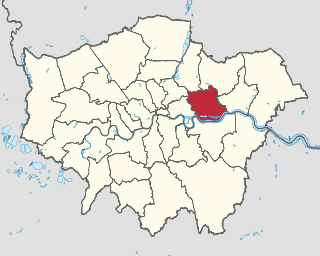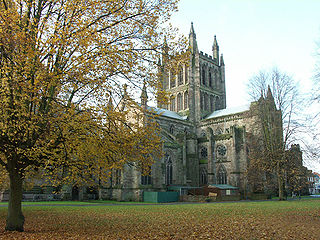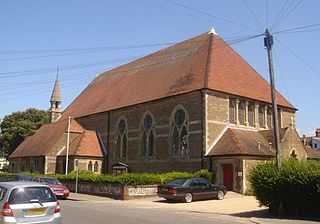
The London Borough of Newham is a London borough created in 1965 by the London Government Act 1963. It covers an area previously administered by the Essex county boroughs of West Ham and East Ham, authorities that were both abolished by the same act. The name Newham reflects its creation and combines the compass points of the old borough names. Situated in the Inner London part of East London, Newham has a population of 387,576, which is the third highest of the London boroughs and also makes it the 16th most populous district in England. The local authority is Newham London Borough Council.

Æthelberht, also called Saint Ethelbert the King, was an eighth-century saint and a king of East Anglia, the Anglo-Saxon kingdom which today includes the English counties of Norfolk and Suffolk. Little is known of his reign, which may have begun in 779, according to later sources, and very few of the coins he issued have been discovered. It is known from the Anglo-Saxon Chronicle that he was killed on the orders of Offa of Mercia in 794.

Stratford Langthorne Abbey, or the Abbey of St Mary's, Stratford Langthorne was a Cistercian monastery founded in 1135 at Stratford Langthorne — then Essex but now Stratford in the London Borough of Newham. The Abbey, also known as West Ham Abbey as it lay in that parish, was one of the largest Cistercian abbeys in England, possessing 1,500 acres (6.07 km2) of local land, controlling over 20 manors throughout Essex. The Abbey was self-sufficient for its needs and wealthy besides; some of this wealth came from the ecclesiastic mills grinding wheat for local bakers to supply bread to the City of London. This later led to competition with the Guild of Bakers, who sought powers to levy a toll on loaves entering the City at Whitechapel.

The Dean of Hereford is the head and chair of the chapter of canons, the ruling body of Hereford Cathedral. The dean and chapter are based at the Cathedral Church of Blessed Virgin Mary and St Ethelbert in Hereford. The cathedral is the mother church of the Diocese of Hereford and seat of the Bishop of Hereford.

St George's Church is an Anglican church in the East Worthing area of the borough of Worthing, one of seven local government districts in the English county of West Sussex. Built in 1867–68 to serve new residential development in the southeast of the town, the Decorated Gothic-style structure was extended later in the 19th century, and expanded its reach further by founding three mission halls elsewhere in Worthing. English Heritage has listed it at Grade C for its architectural and historical importance.

St Mary's Church is a Church of England church in Plaistow in the (East-) London Borough of Newham. With the three churches of St Matthias’, St Martin's, and St Philip and St James’, it now forms part of the Parish of the Divine Compassion. Its Victorian building, designed by Sir Arthur William Blomfield in 1890-1894, was demolished in 1976. They now worship in a smaller church built in 1981.

St Philip and St James’ Church is a Church of England church in Plaistow, east London. It originated as two churches before being merged into the joint parish of St Philip and St James in 1955. That parish in its turn has now become part of the Parish of the Divine Compassion along with three other parishes in Plaistow and Canning Town - St Mary's, St Matthias' and St Martin's.

Holy Trinity Church was a Church of England parish church in Canning Town, east London. Its origins were in the Plaistow and Victoria Docks Mission, set up to serve the growing area of Hallsville by the vicar of St Mary's Church, Plaistow and Antonio Brady. It initially worshipped in the National School on Barking Road until the permanent church opened in 1867, with a parish formed for it the following year by parts of St Mary's and All Saints. Its advowson was initially vested in the bishop, but transferred to the Lord Chancellor in 1886 to allow the benefice of Holy Trinity to be supplemented from revenues from All Hallows Church, London Wall.

St Paul's Church, East Ham or St Paul's Church, Burges Road is a Church of England parish church in East Ham, Newham, east London.
St John the Baptist's Church, East Ham, was a Church of England church dedicated to St John the Baptist in East Ham, east London. It was built in 1866 as a chapel of ease to St Mary Magdalene's Church, then still the main parish church for the area. In 1902 it was converted into a church hall for the new church of St Bartholomew's and in 1925 it was demolished.

St Bartholomew's Church, East Ham is a Church of England church on Barking Road in East Ham, east London dedicated to Bartholomew the Apostle.
St Michael and All Angels Church, Beckton Road, was a Church of England church in East Ham, east London. It opened as a mission of St Mary Magdalene's Church, East Ham in 1883 and immediately rebuilt after burning down three years later. A permanent church was built on a new site around 1906, funded by the Gas Light and Coke Company. A new mission district was formed for it about 1922, but the church was not rebuilt after bombing in 1941 during the London Blitz and ultimately the district was dissolved in 1952, to be merged back into St Mary's parish. St Michael's had also founded two mission churches of its own, St Mark's, Ferndale Street (c.1890) and St Andrew's, Roman Road (1934) - these both closed in 1952 when the district was dissolved.

St Edmund's Church, Forest Gate or the Church of St Edmund, King and Martyr, Forest Gate is an Anglo-Catholic church in the Forest Gate area of Newham, east London. It is dedicated to Edmund the Martyr. It originated in 1895 as the Red Post Lane mission district of All Saints parish. It became a parish of its own in 1901, with a permanent church completed in 1932. It now forms part of the East Ham Team Parish alongside St Mary Magdalene's Church, St Bartholomew's Church and St Alban's Church.
St Stephen's Church, East Ham, was a church on Green Street in East Ham, east London. Its nave and aisles were completed in 1887 and its chancel, north chapel, south chancel aisle, vestries and choir in 1894. It founded three mission churches - St Alban's Church, St Michael's Church, Rutland Road and St Cuthbert's Church, Florence Road.
St Alban's Church, Upton Park is a Church of England church in the Upton Park area of East Ham in east London, England, dedicated to Saint Alban. It was founded by St Stephen's Church as a mission church on Boleyn Road in the Upton Park area around 1889, replaced by a small brick church on Wakefield Street in 1897. It was given a parish of its own in 1903, in which year the nave and aisle of a new permanent church on the opposite side of the same street were completed. Vestries, a Lady Chapel and chancel were added in 1934. Damaged by the London Blitz in 1940, it was repaired in 1949 and now forms part of the East Ham Team Parish alongside St Mary Magdalene's Church, St Bartholomew's Church and St Edmund's Church.
St Michael's Church, Rutland Road is a church in East Ham, east London, originally built for the Church of England. It was established as a mission church of St Stephen's Church, East Ham in 1895, with services held in Saxby Villas, Red Post Lane until the completion of a temporary iron church in 1898. In 1912 a permanent church was built. This housed the congregation of St Stephen's after that church was damaged by bombing in 1940 and after that parish was dissolved in 1953 St Michael's was instead attached to St Edmund's Church. It closed as an Anglican church in 1971 and now houses a Romanian Orthodox church.

The Church of the Ascension, West Ham, or Church of the Ascension, Victoria Docks, is a Church of England church on Baxter Road in West Ham, east London. It was first built in 1887 as a mission hall for St Luke's Church, later put under the charge of the Felsted School Mission, which prior to that had been working in Bromley. Between 1903 and 1907 a new church was built, with a separate parish split from St Luke's in 1905. The new parish opened a mission house for women workers in 1909.

St Andrew's Church was a Church of England church on Barking Road in Plaistow, east London. It began as a small mission built in 1860 on Whitwell Road by St Mary's Church, Plaistow. A permanent church designed by James Brooks opened in 1870 on a site just south of the northern outfall sewer embankment and a separate parish assigned to it the following year. A large central crossing tower with a pyramidal spire was planned but only completed as far as the ridge of the nave roof.
St Gabriel's Church, Canning Town was a Church of England church in Canning Town, east London. It originated as an undedicated iron church between the River Lea and the railway to the north of the Barking Road, on the site later used for the brick-built permanent church of St Gabriel's, consecrated in 1876. Initially a mission of All Saints Church, West Ham, it was given a parish of its own three years after the consecration, using parts of those of All Saints, St Mary's and St Andrew's. It was damaged in the London Blitz and demolished around 1955, with its parish split between St Matthias and St Luke's in 1961.
St Peter's Church was a Church of England church on Upton Lane in the Upton Cross area of Newham, East London. Its origins were in a mission of St Mary's Church, Plaistow on Pelly Road, holding services in a barn then in an iron church. Joseph Lister's former home Upton House was bought by the bishop of St Albans in 1885, becoming the vicarage, whilst its garden provided the site for a permanent church, built in 1893 and given a separate parish the following year using parts of those of All Saints, St Mary's, Emmanuel and St Stephen's. The parish was merged into that of Emmanuel in 1962 - the church was left standing as a chapel of ease to Emmanuel, but its vicarage was demolished, the site being sold in 1968. Funds from that sale and the sale of the parish hall were intended for a new church, church hall and clergy house, but in 1972 St Peter's Church was declared redundant, demolished and its site sold off, leading to the scheme's abandonment three years later.













